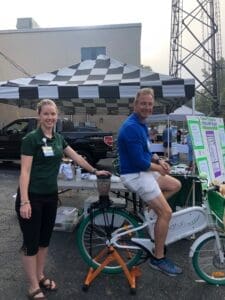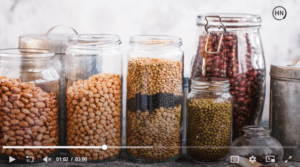Want to Prevent or Better Manage Diabetes? Here are 3 Easy Tips
By Lori Garvin McCall MS, RD, LDN | Clinical Dietitian, Morrison Healthcare
Lori is living Morrison’s cultural value of “Be Well” by promoting wellness in her community.
As a clinical dietitian at Transylvania Regional Hospital in Brevard, N.C., I work with many people to prevent diabetes or manage those that already have diabetes.
If you have diabetes, your body cannot make or properly use insulin. This leads to high blood sugar levels. Healthy eating helps keep your blood sugar in your target range.
But many people who are trying to eat healthy and manage diabetes are usually told to ditch the carbohydrates, right? Carbohydrates are central to nutrition and are found in a wide variety of natural and processed foods, including cereals (wheat, maize, rice), potatoes, and processed food based on cereal flour, such as bread, pizza, or pasta.
While carbohydrates have a direct impact on blood sugar levels, it isn’t the only player in the game. Protein, fiber, and fat all have a significant impact on how fast and how high your blood sugar rises after you eat. To prevent or better manage diabetes, here are three tips that anyone can use:
Don’t Overload on Protein. Protein is the proud peacock of nutrition these days. Food high in protein includes lean meats, poultry, fish and seafood, eggs, and dairy products.
The right amount of protein helps regulate appetite, maintain muscle mass, and minimize blood sugar spikes. But too much protein can become a problem. High-protein diets are linked with worsened kidney function, poorer bone density, and increased mortality in the long term. A daily half-cup of lentils will do you good, but not a daily 12-oz porterhouse steak.
But Eat More Fiber. Fiber is the unsung hero of diabetes management. Even though it’s considered a carb on the food label, it doesn’t act like other carbs. Instead of raising blood sugar, it actually blunts its rise after you eat. So, eating more fiber-rich foods can stabilize blood sugar and prevent those pesky ups and downs after meals.
One of my favorite parts of nutrition counseling is helping my clients unveil some of the mystery behind their blood sugar variability. Fiber is often the key! By eating higher-fiber carbs, they see fewer spikes even without reducing the total number of carbs consumed.
Some of the best high-fiber foods include beans, broccoli, berries, avocados, popcorn, whole grains, apples and dried fruits. One way to get more fiber is to start with breakfast.
Nearly every morning, I eat a large bowl of oatmeal made with soymilk, which combines calcium and protein, along with ground flaxseed – a great source of omega-3 fats and fiber. Sometimes I add cocoa powder or blueberries, both of which add a boost of antioxidants and fiber.
To learn more, check out this 3-minute video for more info.
Limit Consumption of Fats. I can’t tell you how many clients have been attempting a keto diet but still have persistent high blood sugar. It’s not that they’re eating “too many” carbs, but rather that the excessive fat intake makes them insulin-resistant – all the time. Their blood sugar never gets a chance to come down because their dietary fat and circulating blood fat levels are always high.
Fats are nutrients that provide energy, and a small amount of fat is an essential part of a healthy, balanced diet. But large amounts of fat, either through dietary intake or body fat stores, contribute to insulin resistance. These foods include:
- fatty cuts of beef, pork, and lamb.
- dark chicken meat and poultry skin.
- high-fat dairy foods (whole milk, butter, cheese, sour cream, ice cream)
Here’s a sports analogy that may help. Think of glucose — carbs are broken down into blood sugar — as the football, and insulin is the receiver. Insulin is trying to get the glucose down the field (your bloodstream) and into the end-zone (your cells) for energy. However, high levels of fat are playing defense, blocking insulin’s progress from reaching the goal line.
One solution is a plant-based diet. If a plant-based diet sounds too intimidating or just not your cup of tea, think of dishes you already enjoy –bean chili, vegetable lasagna, fajitas, and casseroles are all commonplace plant-based dishes that won’t trigger a raised eyebrow at your next potluck.
How a Registered Dietitian Can Help

Registered dietitians (RDs) are specially trained experts in the chemistry, biology, and the psychology behind nutrition. People who visit RDs for their diabetes management are more likely to see improvements in blood sugar, weight, and other measurements of health than those who try to figure it out on their own.
An RD can help you figure out why your blood sugar was high or low at one meal and how to improve it at the next. An RD can work alongside you to clarify your health goals and how your food choices can accelerate success.
To connect with a local RD, discuss it with your primary care doctor, who can send a referral for you. Click here (link https://www.eatright.org/find-a-nutrition-expert) to explore RDs in your area.





